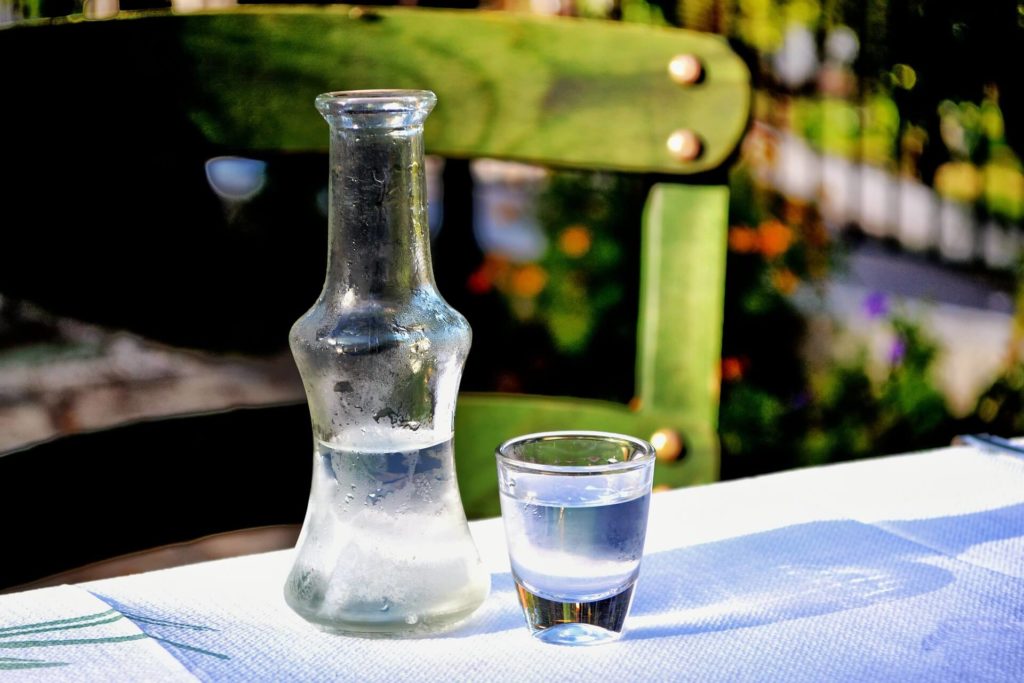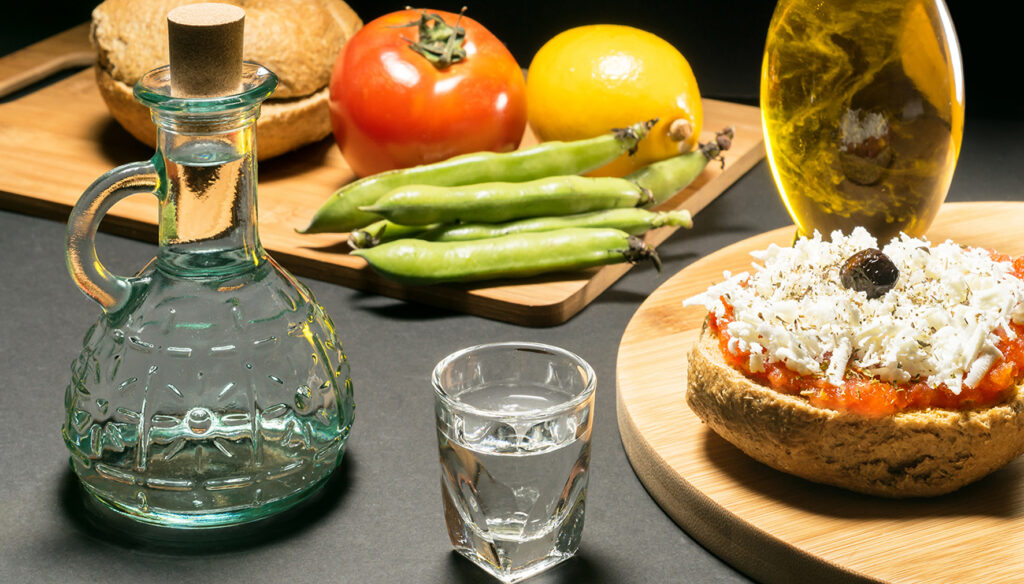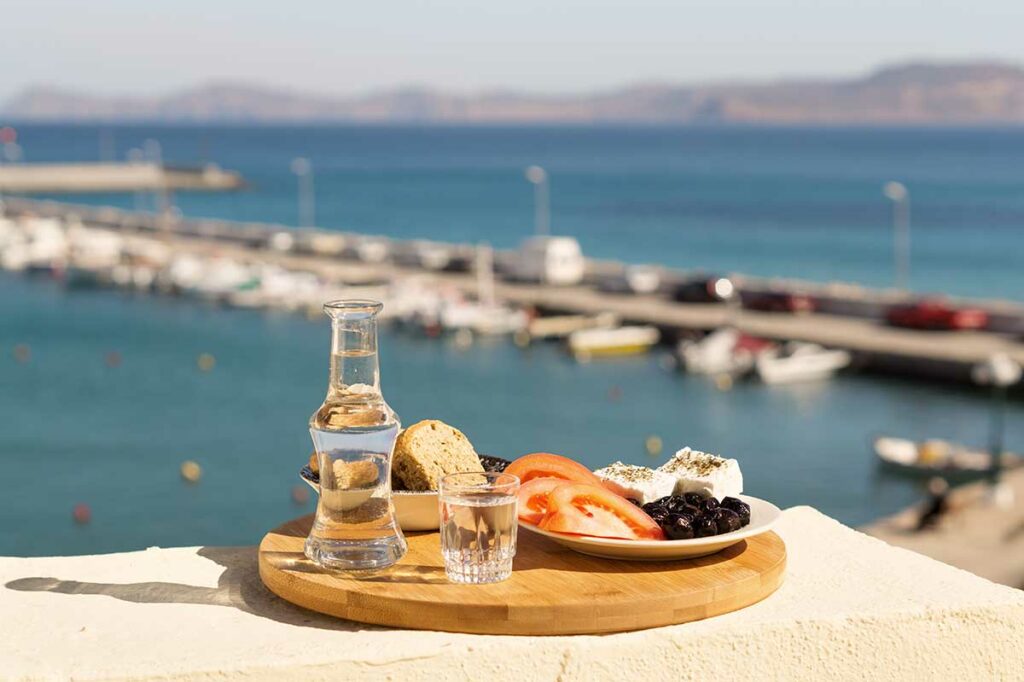START BOOKING YOUR TRIP TO Crete
** Please note that we get a small commission if you book via our referral links. We use this to invest in new foodie content and to update the Greece Foodies website.
Cretan Raki : Everything You Should Know
Every time I consider Cretan raki, memories flood back into my head. I see visions of people grinning in the Cretan mountain villages. people who don’t make excessive demands. Although they had a difficult life, they overcame it with fortitude and a permanent smile on their faces. Even if they weren’t sure whether they’d be able to have such things tomorrow, they knew that a few friends, a salad from their backyard, some bread, and some Cretan raki for everyone to share, might make them happy. the people who were actually joyful and lively.
Before I start writing more about this phenomenal spirit, I want to make clear that raki is equal to Cretan hospitality. It’s a drink that creates memories. It’s a drink that creates friendships. True friendships. It’s not a drink that you should get wasted on, so please treat it with respect.
And now it’s time for some small talk and facts about Cretan raki…
Read more: Top-10 best Cretan Food to Try
History of Cretan Raki

The history of distillation of this drink goes back in time, around seven to eight centuries ago. Rumors say, that the monks of Mount Athos are the first people who made this drink. They started cultivating land and they wanted to make the most out of their land while treating it with respect. And that’s how they were also treating the vines that they had. It started with the fruit of the grapes. Then it went on with using their leaves, their sprouts, their stem and eventually the trunk. Initially, they were using only the fruit, the most important part of the juice extraction process, by making wine, a drink that is widely known from the ancient times. In order to use the remaining of the wine process, instead of throwing it away, Cretan raki was born.
It quickly spread out to Greece and even to Mediterranean countries, with of course a lot of changes from the original recipe. For the Greek people making raki was an excellent way of getting an extra income and so the governments gave the first licenses for raki production. Then the distillation process became a tradition, with each new generation, that inherits the methods, the recipes and knowledge of the distillation process for their ancestors.
Check out our Crete Food Guide for for blog posts about food in Crete
Procedure
The mass that is left over after manufacturing wine serves as the primary ingredient in the process of making tsikoudia. This mass includes the grape meat (75-85%), seeds (3-6%), and a little amount of juice that is still in the peels. It also comprises grape peels (6-9%). If you let the grapes ferment naturally, the fermentation process’ first step takes around a month. The first distillation is where we get 15% to 20% of the original mass. We then proceed to the second distillation, filling the cauldron between 80% and 90% of the way full and discarding the initial 0.5 to 1 liter. The remaining 50% of the first mass used in the second distillation is gathered, and the remaining portion is discarded to be used in the subsequent first distillation. Tsikoudia typically has an alcohol content between 38% and 45% abv.
💬Are you planning to visit crete? Read our Ultimate Crete Travel Guide for 2023
GreeceFoodie’s Services for Crete
Name & Variants
The name raki for this alcoholic drink in widely used in Crete and even in Greece. But is it correct? Should we stop using it? What about all the other alcoholic drinks like tsipouro, grappa, arrak, etc.?
At 1989 names of some alcoholic beverages were authorized by the EEC. Turkey registers the name “Raki”. Greece registers the names “Tsikoudia of Crete”, “Tsipouro of Tyrnavos”, “Tsipouro of Macedonia” and “Tsipouro of Thessaly”. So the name raki that is common throw-out Greece is Turkish name but everyone in Greece will understand what you are talking about and you will insult no one if you use the name raki instead of tsikoudia.
There are also a lot of variants around the Mediterranean. Some of them are grappa in Italy, zivania in Cyprus, Arrack in Middle East and much more. (Do not confuse Arak with Arrack which is different drink)
🏠 Greece Foodies’ favorite hotels in Chania, Greece: Notus Chania Crete , Camere Maritima , Porto Del Colombo Traditional Boutique Hotel
How & when to drink Cretan raki

Serve tsipouro chill in shot glasses with some food (small quantity aka mezes) to accompany it. Perfect mezes in Crete is some Cretan cheese or just some rusks with olives. Adding honey in raki is another way of drinking it. And it also has a special name rakomelo (combination of the words raki and honey).
Best time to drink, is when you have good company around you and some food to eat while drinking. And keep in mind this is a strong in alcohol spirit. Some food and water are essential in order to keep you sober. Learn about the differences between Raki and Ouzo
Discover Crete tours to enjoy authentic Cretan Raki
Cultural Significance and Traditions

Cretan Raki, also known as Tsikoudia, holds a significant place in Cretan culture and traditions. This authentic Cretan spirit, akin to Italian grappa or Irish whiskey, has been distilled for centuries, making it an integral part of the region’s heritage. The process of raki distillation is deeply rooted in Cretan tradition, with families often passing down their distillation techniques and secrets from one generation to another.
Raki is not simply a drink in Crete; it is a symbol of conviviality and hospitality. In social gatherings and celebrations, raki is served as a gesture of warmth and friendship. The serving of raki is accompanied by various traditions, such as the use of special glassware and the specific pouring techniques that enhance the aroma and flavor of this pure Cretan spirit.
Cretan Raki, with its peppery and fruity flavor, captures the essence of the island’s terroir and is an embodiment of Cretan tradition. The process of making Cretan raki involves the careful selection of ingredients and the use of traditional methods, including the use of a raki cauldron for distillation. Each step in the production process is carried out with utmost care to ensure the creation of a pure raki that showcases the unique flavors of Crete. This commitment to quality and authenticity is deeply ingrained in Cretan culture, making raki an indispensable part of the Cretan way of life.
Culinary Uses and Pairings of Cretan Raki: A Taste of Cretan Tradition
Cretan Raki, also known as Tsikoudia or Cretan Tsikoudia, is a beloved traditional spirit in Crete and a versatile ingredient in Cretan cuisine. Its unique flavors and aromas make it an excellent addition to various dishes, enhancing the overall culinary experience. Let’s explore the culinary uses of Cretan Raki and some delectable food pairings that bring out the best in this cherished spirit.
1. Culinary Uses of Cretan Raki in Traditional Cretan Cuisine
a) Flavoring and Marinating: Cretan Raki’s distinct taste, with hints of fruit and herbal notes, makes it an ideal marinade for various meats, especially lamb and pork. Marinating the meat in Raki before cooking imparts a subtle, delightful flavor that elevates the dish to a whole new level.
b) Sauces and Dressings: Cretan Raki can be incorporated into sauces and dressings to add depth and complexity to dishes. Its rich flavors blend harmoniously with olive oil, lemon juice, and herbs, creating tantalizing sauces for salads, seafood, and grilled vegetables.
c) Desserts and Baking: Cretan Raki is often used to flavor pastries and cakes in traditional Cretan desserts. When added to cake batters or dessert fillings, it infuses the treats with a delightful warmth and aromatic sweetness.
d) Confections and Preserves: Cretan Raki finds its way into a variety of confections and preserves, adding a unique touch to fruit compotes, jams, and even honey-based sweets. Its flavor acts as a natural enhancer, complementing the natural sweetness of fruits.
2. Food Pairings that Complement Cretan Raki
a) Cretan Cheeses: Cretan Raki pairs exceptionally well with the region’s artisanal cheeses, such as graviera, kefalotyri, or myzithra. The combination of creamy and savory cheese with the smooth, herbal undertones of Raki creates a delightful contrast of flavors.
b) Fresh Seafood: The briny and delicate flavors of fresh seafood, such as grilled octopus or shrimp saganaki, harmonize wonderfully with the herbal notes of Cretan Raki. It creates an excellent pairing for a delightful seaside meal.
c) Grilled Meats: The bold and smoky flavors of grilled meats, especially lamb or pork, complement the subtle sweetness of Raki-infused marinades. Together, they create a symphony of taste that is truly a culinary delight.
d) Mediterranean Vegetables: Cretan Raki pairs wonderfully with grilled or roasted vegetables like eggplants, zucchinis, and peppers. The earthy flavors of the vegetables mingle seamlessly with the herbaceous tones of Raki.
3. Popular Recipes Incorporating Cretan Raki
a) Raki-Marinated Lamb Chops: Marinate lamb chops in a mixture of Cretan Raki, olive oil, garlic, lemon juice, and fresh herbs. Grill or roast the lamb chops to perfection for a succulent and flavorful main course.
b) Cretan Raki and Honey Roasted Figs: Drizzle fresh figs with a mixture of Cretan Raki and honey. Roast the figs until caramelized and serve them with Greek yogurt or a scoop of vanilla ice cream for a simple yet exquisite dessert.
c) Raki-infused Salad Dressing: Create a delightful salad dressing by combining Cretan Raki, extra virgin olive oil, lemon juice, Dijon mustard, honey, and a touch of crushed garlic. Toss it with fresh greens, cherry tomatoes, cucumber, and feta cheese for a refreshing salad.
d) Raki-infused Orange Cake: Add a splash of Cretan Raki to your favorite orange cake recipe for a unique twist on a classic dessert. The Raki infuses the cake with a warm, aromatic flavor that complements the citrusy notes of orange.
Whether you’re exploring traditional Cretan cuisine or experimenting with creative culinary endeavors, Cretan Raki is a versatile and rewarding ingredient to incorporate into your dishes. From savory marinades to sweet desserts, the rich heritage of Cretan Raki enhances the flavors of your creations, leaving you with an authentic taste of Cretan tradition. Enjoy this cherished spirit responsibly and savor the delicious culinary journey it can take you on.
Cretan Raki in a Nutshell
In conclusion, Cretan Raki, also known as authentic Cretan Tsikoudia, holds a special place in Cretan culture and traditions. This pure Cretan spirit, with its distinctive peppery and fruity flavour, is more than just a drink—it is a symbol of conviviality, hospitality, and the rich heritage of Crete. Throughout history, greek raki distillation has been deeply ingrained in Cretan tradition, with families passing down their techniques and secrets from one generation to another.
Exploring the cultural significance and traditions surrounding Cretan Raki unveils a world of warmth and friendship. From the serving customs to the use of specialized glassware, every aspect of enjoying raki in Crete is steeped in tradition. It is not just a drink; it is an experience that captures the essence of Cretan hospitality and the vibrant spirit of the island.
Cheers to all the friendships that were made while sipping Cretan raki, cheers to all the laughers, cheers to health and good times!
Yamas!
A team of foodies, cooks, and travelers. Alios Tours was founded out of our passion for Greek food. We share the delicious side of Greece.
















